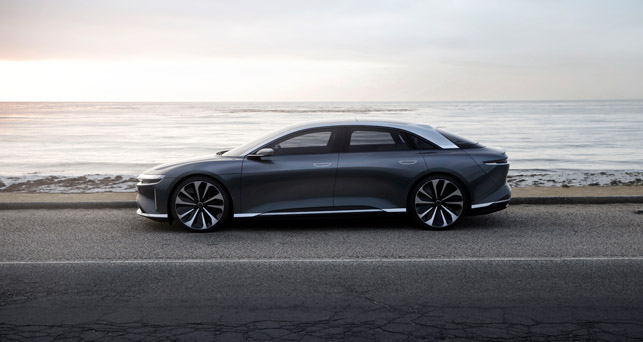A recent event brought to the fore the challenges that the electrification of vehicles is bringing to engineering and design. Al Dean considers what happens when you break away from over a century of prior art

The Air from Lucid Motors —three years from blank sheet of paper to a road going 1,000hp, 100% electric beast
This last month I had the pleasure of attending Ansys’ User General Meeting in Tokyo, where the second day’s proceedings were given over to an automotive focussed summit, apt considering that Japan is still one of the leaders in the automotive world (third, by units produced, in fact).
The focus for much of this was around electrification and preparation for the near future’s move towards autonomous driving.
Of course, the electric car is almost as old as those running with an internal combustion engine, but the availability and practicality of generation and storage of the required energy source, as well as the business behind it’s generation, meant that the petro-chemical industry took hold instead.
If you look to the in-home energy industry, although electricity was a front runner alongside pneumatic and gas for many decades (I’d recommend reading Powering the Dream by Alexis Madrigal), it didn’t take off in comparison to its fuel burning cousins.
It wasn’t until the 1990s when climate change and emissions became a serious concern and combined with improvements in battery technology, it meant that we started to see a rebirth of interest in electric transportation.
While many tried (GM’s EV1), it wasn’t until the Toyota Prius that things started to get serious — the Prius shifted 18,000 units in the first year alone.
In the years since, both the full electric and hybrid vehicle markets have grown. Just this year, we passed two million cars globally and, albeit small potatoes compared to the traditional vehicle market (around 88 million in 2016), it’s growing.
From the Ansys event it was clear that the combination of hybrid and fully electric vehicles with the push towards a future of autonomous driving is creating some truly interesting opportunities and engineering challenges.
Two presentations stood out: one from automotive powerhouse Ferrari and another from a new silicon valley start-up, Lucid Motors.
Ferrari detailed the challenges involved in developing its first hybrid drive vehicle, Laferrari. This is a beast of a machine, bringing together Ferrari’s famed styling and performance with a power plant that makes most super cars weep.
The combination of hybrid drive and some seriously smart engineering decisions mean that you’ve got a car that’ll outperform almost anything, but with dramatically lower emissions compared to your average saloon.
The peculiarities of hybrid drive gave Ferrari’s engineering team some real challenges, looking to maintain the midengine configuration, but fitting in all of that extra equipment and systems.
The end result is a car that has the same performance you’d expect from a Ferrari, but which takes advantage of the newest technology available to recover energy where needed and give you the performance you’d expect. A few curious facts came out of this presentation.
One being that if you can lower the centre of gravity by 10mm, that’ll equate to a 2.2 second reduction in lap time at the Nürburgring.
It was also fascinating to see Ferrari pick apart the emissions legislation. According to the presentation, all vehicles are judged on the same measures, but those don’t take into account use patterns and units sold. With Ferrari being driven dramatically fewer miles and sold in fewer units, the emissions were much more favourable than the average mid-sized sedan.
The Lucid Motors presentation, on the other hand, detailed how this start-up had moved from a blank sheet of paper to functional prototype in just three years. Albeit the team has some serious chops and funding, the results are impressive.
Lucid detailed how it is using simulation to solve some of its unique challenges from the effect of design and cooling with its patented intake design, to judging the effect of its luxury reclining seats in the back on suspension and performance, through to electro-magnetic simulation of its motors.
One of the many interesting case studies it detailed involved using Ansys’ Maxwell system to study magnetic flux in its motors. This information was then used directly to build look up tables that shipped in the embedded systems in the vehicle’s motor control unit — the end result being better performing motors (this is 100 per cent electric and gives you 1,000bhp), but with the added bonus that the team didn’t have to spend a small fortune on dyno tests with a physical car.
What I learnt from the event was that while electric or hybrid cars are sold on economy and their reduced impact on the environment, the high-space is starting to catch up.
Although Tesla is predominately getting all of the headlines, there are both legendary marques and new start-ups coming up right behind them and they’re using simulation to its full advantage to make the design and engineering process as efficient as the vehicles that result from it.
The challenges the electrification of vehicles is bringing to engineering and design
Default






